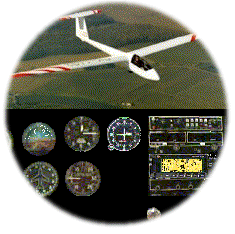Descent
During descent proper engine management is essential. Good engine conservation practices require a gradual power reduction and conservative descent airspeeds. In fact, studies indicate that airspeed may be more critical than power reduction. Therefore, every attempt should be made to avoid airspeed acceleration and power reduction for three minutes after glider release. Full flaps or slipping turns can be used to obtain a suitable rate of descent. Closing cowl flaps, if available, will further reduce the rate of engine cooling. Realize oil temperature is not as reliable as cylinder head temperature for managing temperature change. Each airplane requires slightly different techniques, however, the goal is to keep the engine as warm as possible while descending at a reasonable rate.
Collision avoidance is always a high priority, since descending flight attitudes increase the potential of a mid-air collision. Consider developing and using specific descent corridors that are void of glider and power traffic.

A picture you don’t want to see!!
Always make descending turns, clearing your descent path.
Approach & Landing
A 200-foot tow line hangs down behind the tow plane at a 30 to 40 degree angle. The altitude of the tow plane must be adjusted to ensure the tow line does not become entangled in obstructions at close proximity to the ground.
Ensure you are thoroughly briefed and familiar with the obstructions around the airport, especially obstructions on the approach end of the runway to be used. Your briefing should include a minimum AGL obstruction crossing height and any factors that may influence your altitude judgement, such as visual illusions or other airport distractions.

Landing with the tow line attached is not prohibited by regulation. However, the following points should be considered:
- Obstructions are cleared by more than the tow line length (altimeter lag considered) and
- the field is well turfed. It is simply inviting early tow line failure from abrasion to land with the tow line on hard ground or paved runways. Landing with the tow line should never be attempted unless the field has clear approaches and is at least 2500 feet in length.
Other situations require the tow line to be dropped, normally in the glider launch area, during short approach to the runway. If the tow line is to be dropped, the tow pilot must be constantly aware of the launch area situation. The tow line drop area must be defined and ground personnel must be briefed and aware of the drop area. Ground personnel must stay clear of the drop area and the presence of an individual in the drop area, will require an immediate go-around by the pilot of the tow plane without dropping the tow line.



Where is there an SSA or SSF description of Glider “Descent-Approach-Landing”?
Tim Lockert
Chief Flight Instructor
Central Alabama Soaring Association
(205) 410 9535
tim @le-3.net